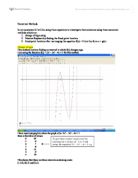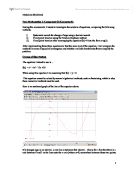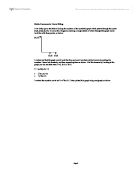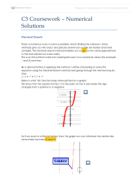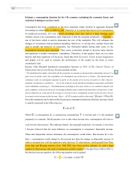The diagram shows a house built with dominoes. This house has four stories and uses 24 dominoes.Simon broke the World Record by building a domino house with 73 stories. How many dominoes did he use?
DOMINO HOUSE The question that we have been given to solve is: The diagram shows a house built with dominoes. This house has four stories and uses 24 dominoes. Simon broke the World Record by building a domino house with 73 stories. How many dominoes did he use? Investigate To summarise the question about Domino House it is asking you to find how many dominoes are used in n stories to then be able to find out how many dominoes are in 73 stories. Method There are many parts that I will want to include in my project to be able to find the answer and to also allow the reader to understand exactly what I'm doing step by step. I will also explain each section as I work through the investigation. The sections that I will include in my project are to set out the project and make it simple to understand. Firstly I will use diagrams to make my project easy to understand. I will try to work systematically to make the project simple to understand. I will then draw a results table where I will comment on why I am using the results and what purpose it has in my project. I will also explain if I can spot any patterns. After I spot the patterns I will work out the differences. Next, using the differences I will draw a differences table, which will give us the rules (either being linear and quadratic). Using these rules I will draw a graph, and if the graph has a straight line then
In my coursework I will be using three equations to investigate their solutions using three numerical methods which are: change of sign using Newton-Raphson by finding the fixed point iteration fixed point iteration after rearranging the equa
Numerical Methods In my coursework I will be using three equations to investigate there solutions using three numerical methods which are: . change of sign using 2. Newton-Raphson by finding the fixed point iteration 3. fixed point iteration after rearranging the equation f(x) = 0 into the form x = g(x) Change of sign This method involves finding an interval in which f(x) changes sign. I am using the function f(x) = 2x³ - 5x² - 4x + 1 for this method I have used autograph to show the graph of y= 2x³ - 5x² - 4x + 1 Here is the table of values -2 -27 -1 -2 0 -6 2 -11 3 -2 4 33 This shows that there are three intervals containing roots: [-1,0], [0,1] and [3,4]. It can be seen that f(-1) > 0 and f(0) < 0 so there is a root in the interval [-1,0]. Bisection In this method the interval is successively halved by looking at the value of f(x) at its mid-point. For the root in the interval [-1,0], you next try an x-value of-0.5. f(-0.5) = 1.5 -0.75 0.34375 -0.875 -0.66796875 -0.8125 -0.123535156 -0.78125 0.119567871 -0.79688 0.000365464 Since this is positive the root lies in the interval [-1,-0.5]. The next value I'll try is the midpoint of the new interval, -0.75 f(-0.75) = 0.34375 f(-0.875) = -0.66797 So I can see that the root lie between -0.75 and -0.875 So I now try and find the root by finding f(x) of the mid point between
newton raphson
Numerical solutions of equations. Decimal Search We will look at the polynomial equations which cannot be solved by algebraic methods. All linear and quadratic equations can be solved algebraically so we are interested in equations with powers of x3 at least. The first method to be looked at is the Decimal Search. This involves finding an interval of the x- axis in which a root of the equation lies. Let's consider the function: y=x5+4x2-2. The region to scan to find the first root is -4<x<4. x f(x) -4 -962 -3 -209 -2 -18 -1 0 -2 3 2 46 3 277 4 086 We can identify three intervals which have a change of sign: [-2,-1] , [-1,0] , [0,1]. If we sketch the graph of the function three roots are confirmed in these intervals: I'll draw a sketch to show the curve crossing the x- axis in this interval. I am going to concentrate my search on this interval [0,1] and look at interval of width 0.1 unit. x f(x) 0.000000 -2.00027 0.100000 -1.95999 0.200000 -1.83968 0.300000 -1.63757 0.400000 -1.34976 0.500000 -0.96875 0.600000 -0.48224 0.700000 0.12807 0.800000 0.88768 0.900000 .83049 .000000 3 The change of sign occurs in [0.6 , 0.7] which is where the root lies. This process can now be continued using intervals of width 0.01 then by using intervals of width 0.001 etc. Below I will show those intervals and I will bold and highlight
Investigate the solution of equations, comparing the following methods, Systematic search for change of sign using a decimal search, Fixed point iteration using the Newton-Raphson method, Fixed point iteration after rearranging the equation f(x)=0 into th
Pure Mathematics 2: Component 02 (Coursework) During this coursework, I intend to investigate the solution of equations, comparing the following methods. i) Systematic search for change of sign using a decimal search ii) Fixed point iteration using the Newton-Raphson method iii) Fixed point iteration after rearranging the equation f(x)=0 into the form x=g(x) After implementing these three equations to find the same root of the equation, I will compare the methods in terms of speed of convergence and whether available hardware/software simplify the problem. Change of Sign Method The equation I intend to use is... f(x) = x³ - 4x² - 11x +10 When using this equation I am assuming that f(x) = y = 0 This equation cannot be solved by normal algebraical methods, such as factorising, which is why these numerical methods must be used. Here is an unaltered graph of the line of the equation above. If y changes sign in an interval, a root lies in between that interval. I know for a fact that there is a root between 0 and 1 as the lines cuts the x-axis (where y=0) somewhere between those two points. f(0) = 10 f(1) = -4 There is a change of sign between these points, which further confirms my theories. As this is to no decimal places at the moment, I will use Excel to break the change of sign down further to pin-point it exactly. I have highlighted
Maths Coursework: Curve Fitting
Maths Coursework: Curve Fitting I was firstly given the task of finding the equation of the quadratic graph which passes through the points (5,0), (3,0), (0,15). To solve this I began by drawing a rough sketch of what I thought the graph would look like with these points, as below: (0,15) (3,0) (5,0) I worked out that the graph would look like this, and next I worked out the formula by putting the numbers I knew into brackets, and then expanding them as below. I did this because by looking at the graph you can see that when Y=0, X=5 or X=3. Y = (x-5)(x-3) = 0 * x2-3x-5x+15 * =x2-8x+15 I worked the equation out to be Y=x2-8x+15. I then plotted this graph using omnigraph as below: I then went onto the second task of finding the equation of the quadratic graph which passes through (0,9) and touches the x-axis at (3,0). I used the same method as before, of drawing what I thought the graph would look like: (0,9) (3,0) I then put the numbers into brackets again (as below), because I worked out that when Y=0, X=3, and no other number. Then once again expanded the brackets to find the formula: Y=(x-3)(x-3) = 0 I worked out the formula to be: Y=x2-6x+9 I could be sure that this was the correct equation because the co-ordinate was (0,9) which shows that the graph passes through +9, and the above equation proves this. I decided to find the equation of the graph
Best shape for gutter and further alegbra - using Excel to solve some mathematical problems.
EDM 252 Using and Applying Information Technology in Mathematics 1 Assignment 1 ) A length of guttering is to be made by taking a rectangular piece of plastic and folding up the edges. The dotted lines symbolise the folding of the edges. Let the measurements be units (as no specific measurements are given) Volume max = Area of cross section max x length Since the length is just a multiplicative constant, maximizing the volume is the same as maximizing the cross sectional area. Therefore the area of cross section max will determine the maximum volume of the gutter. Using a width of 10 units, I will investigate the different types of cross sections that could be used. The first obvious shape to construct would be a square cross section. Square Cross section Area = height x width Area =) x ) = Trapezium cross section To find the maximum volume I need to establish a relationship between the three variables ?, width of base and Volume. We can do that from the following diagram: Area = (1/2) * h * (a + b) where h = (w - a) cos (?) (height) a = a (first parallel side) b = a + 2(w - a) sin (?) (second parallel side) To calculate angle ?, I have taken the vertical perpendicular to the base as the starting point at ? = 0, Firstly, due to the 3 variables I fixed a and w-a to be equal length and varied
Change of sign.
Change of sign Bisection Success The success of the bisection method can be proved by using the following equation: f(x) = 0.64x4+0.28x2-2x+0.28 For this method, I have chosen to find the root between 0 and 1. Below is the process taken to find this root, each table represents zooming in once (halving the window e.g. first window is 1 unit, second window is 0.5 units). Lower Bound Middle Value Upper Bound Lower Bound Middle Value Upper Bound 0.000000 0.500000 .000000 x 0.000000 0.250000 0.500000 x 0.280000 -0.610000 -0.800000 f(x) 0.280000 -0.200000 -0.610000 f(x) Lower Bound Middle Value Upper Bound Lower Bound Middle Value Upper Bound 0.000000 0.125000 0.250000 x 0.125000 0.187500 0.250000 x 0.280000 0.034531 -0.200000 f(x) 0.034531 -0.084365 -0.200000 f(x) Lower Bound Middle Value Upper Bound Lower Bound Middle Value Upper Bound 0.125000 0.156250 0.187500 x 0.125000 0.140625 0.156250 x 0.034531 -0.025283 -0.084365 f(x) 0.034531 0.004537 -0.025283 f(x) As to achieve the desired accuracy (of 3 decimal places) this process had to be repeated many times, the last of which is shown below: Lower Bound Middle Value Upper Bound Lower Bound Middle Value Upper Bound 0.142975 0.14299 0.143005 x 0.14299 0.142998 0.143005 x 4.14E-05 .23E-05 -1.7E-05 f(x) .23E-05 -2.3E-06 -1.7E-05 f(x) Shown
Experimentally calculating the wavelength of an He-Ne laser by means of diffraction gratings
EXPERIMENTALLY CALCULATING THE WAVELENGTH OF A He-Ne LASER BY MEANS OF DIFFRACTION GRATINGS Purpose: To experimentally determine the wavelength of a He-Ne laser, by means of three different diffraction gratings - 600 lines/mm, 300 lines/mm, and 100 lines/mm. Background Information: "The deviation of light from its original path as it passes through a narrow opening or around an obstruction is called diffraction."1 When light is pointed through one slit, the light is diffracted and creates an "interference pattern" on a screen a certain distance away. On this screen, various "fringes" of light are displayed through destructive interference, along with a bright vertical beam of light in the center. The fringes are less bright beams of light on either side of the central beam - the first fringes on either side are called "first order fringes," the second fringes on either side are called "second order fringes," and so on. Theoretically, the distances from the central beam and each of the first order fringes should be equal, as should be the distances from the central beam and each of the second order fringes, and so on. When light is passed through two slits, the central bright beam of light is created through constructive interference of the light through the two slits. In the case of constructive interference: dsin? = m?, where d is the distance between the slits, ?
Systematic search for a change of sign - pure maths
Pure 2 Coursework Task I) Systematic search for a change of sign. We are looking for solutions to f (x)=0, i.e. where the curve crosses the x-axis. The first thing to do is to draw a graph. For this method, initial boundary values are needed, and a graph is a good way to do this, and to check that the particular equation can be solved using this method. It is convenient if the boundary values c & d are a whole unit apart e.g. 2 and 3.It will be noted that c and d have opposite signs, in this example c is -ve and d +ve. Now, you have to calculate f (x) for x, which is incremented in steps of 0.1 from c to d. The resulting table might look like this: Decimal Search X = c + 0 0.1 0.2 0.3 0.4 0.5 0.6 0.7 0.8 0.9 .0 f(x) -ve -ve -ve -ve -ve -ve -ve +ve +ve +ve +ve We now know that the root we are looking for lies between: c+0.6 and c+0.7 because this is where there is a change of sign and the graph obviously crosses the x-axis. Also note that you only need to calculate values until there is a change of sign, one need not go further. These are the limits for the root, which must lie between them. We can find the next decimal value of the root by repeating this method using an interval of 0.01 . Once further bounds are found you can repeat the decimal search using an interval of 0.001 and so on to the required accuracy. I am going to use this
Numerical solution of equations, Interval bisection---change of sign methods, Fixed point iteration ---the Newton-Raphson method
Numerical solution of equations Introduction What is numerical method? We may occasionally encounter some equations which cannot be solved by algebraic or analytical method. In order to obtain the answers, numerical methods can be used for solving those equations. In this coursework, I am going to use three numerical methods to solve the cubic and non-trivial equations. The methods are shown as follows: * Interval bisection---change of sign methods * The Newton-Raphson method---fixed point iteration * Rearranging the equation f(x)=0 into the form x=g(x)---fixed point iteration Each method shown above will be applied to one different cubic and non-trivial equation. In addition to the application, I will compare the other two methods by applying one of the three equations, thereby comparing their ease of use and speed of convergence. *in this coursework, programme including Microsoft Excel (used for calculations) and Autograph 2.10 (used for drawing graphs) will be used so as to enhance the process of the coursework. Interval bisection---change of sign methods Given that the equation y=f(x) is a continuous function in which no asymptotes or other breaks occur, we look for the roots of the equation f(x) = 0. In the usual case, all we need to do is just to factorize the formula and then solve the equation easily. In this case, a formula y = (2x-3)(x+1)(x-2)- which is



